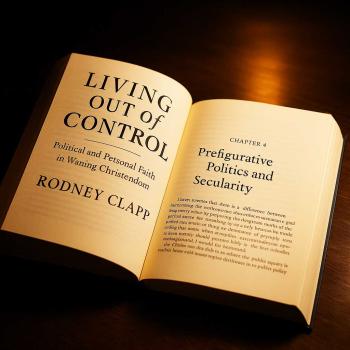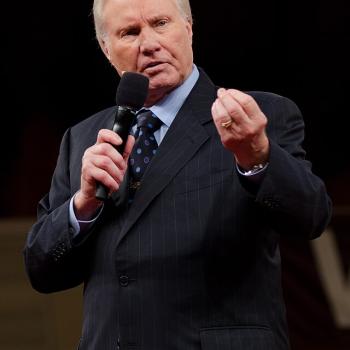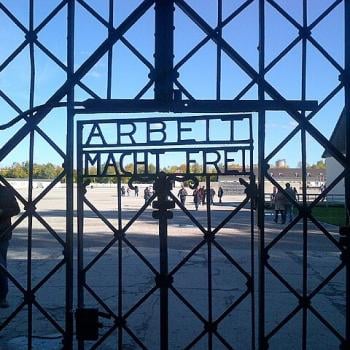Needed: A New “Progressive Orthodoxy” for the 21st Century: Part Three (Final) of Series about Horace Bushnell
In the first two installments of this three part series I talked about what Gary Dorrien calls Bushnell’s “liberal-leaning experiment in progressive orthodoxy” with special focus on the 19th century theologian’s theological method. Here I want to suggest some ways in which Bushnell’s progressive orthodoxy can be helpful today.
As in Bushnell’s time and place (New England in mid-19th century), Protestant Christianity in America today is deeply divided between conservatives of various kinds and liberals of various kinds. And, among evangelicals, a gulf is widening between those I call postconservatives (including progressives and moderates) and neo-fundamentalists (conservative evangelicals). Notably missing is viable, attractive, influential middle ground.
In my estimation, what American theology needs is what Bushnell (and a few others) provided in mid-19th century New England: an attractive mediating theology that takes orthodoxy seriously but is willing to explore new horizons and frontiers in doctrinal reconstruction. Theologies of retrieval abound and are attracting many conservative-minded young people. These are either paleo-orthodox (retrieving and renewing ancient Christian teaching) or neo-fundamentalist (retrieving and usually entrenching the “received evangelical tradition”). Needed is a vision of orthodoxy in which it is living. Jaroslav Pelikan quipped that “Tradition is the living faith of the dead while traditionalism is the dead faith of the living.” Too often, I fear, orthodoxy today is the dead faith of the dead. Progressive orthodoxy is the attempt to breathe new life into it and make it relevant (without relativism) to contemporary people.
Theologies of revision also abound. Among so-called “mainstream” Protestants there is new interest in process theology and various left-leaning political theologies of inclusion and social transformation. Among evangelicals, many younger people are attracted to revisionist theologies as espoused by some of the more progressive emerging church gurus. These often seem to repeat the liberal Protestant experiments of the later 19th century and early 20th century.
In the midst of the theological convulsions shaking New England Protestantism in the mid-19th century Bushnell attempted to provide a middle way, a via media, that took seriously the new knowledge of the sciences and new paths of philosophy while at the same time holding on to crucial doctrines of orthodoxy such as the Trinity. (Bushnell was a strong defender of the Trinity against the growing Unitarianism of his time and place.)
When people hear the phrase “progressive orthodoxy” there are usually two reactions. Conservatives hear only the “progressive” part and are deaf to the “orthodoxy” part. They react to it as if it were nothing but a new form of the old liberalism. Bushnell was no liberal; he believed in and defended the supernatural, the deity of Christ, the atoning death of Christ as more than a moral example. He was not a reductionist nor was he anxious to rush into accommodation to “modern thought.” Although he did believe it important to moralize dogma, he was not interested in reducing Christianity to ethics (which was the trend among the true liberals of his day).
The second reaction is from liberals who only hear the “orthodoxy” part and are deaf to the “progressive” part. They react to it as if it were nothing but a new form of fundamentalism, but Bushnell was no fundamentalist. He did not believe in biblical inerrancy (a concept he thought was foreign to the nature of Scripture as narrative and imagery), every biblical miracle (although he believed some biblical miracles are necessary such as Jesus’ resurrection), or that correct doctrine is the essence of authentic Christianity.
Like Bushnell, a new progressive orthodoxy would be a conscious via media between neo-fundamentalism that elevates correct doctrine to the sine qua non of authentic Christianity and neo-liberalism that reduces doctrine to unimportance. It would acknowledge that certain beliefs are necessary to holistic, mature Christianity in every place and time, namely the deity and humanity of Christ, the supernatural (that God sometimes acts in ways that transcend the laws of nature), the grace of God in salvation, and the Trinity (to name the most important ones). However, it would be open to reconsideration and revision of the ways in which doctrines have traditionally been formulated and expressed.
The new progressive orthodoxy would, like Bushnell’s, regard communion with God as the essence of authentic Christianity and emphasize spirituality as equally important, if not more important, than correct belief. It would recognize the distance between all human doctrinal formulations and the reality they aim to express. It would encourage Christian engagement with culture (science and philosophy especially) without capitulation to secularism or consumerism or “New Thought.” It would encourage the ongoing process of devout and faithful theological research that critiques and reconstructs traditional doctrinal formulations while at the same time holding firmly to the basics of the faith “once for all delivered.”
Bushnell’s lifelong work on the atonement is the best example of his own progressive orthodoxy at work. He refused to reduce the cross to a moral example and influence; he knew the biblical imagery of Christ’s sacrifice required an objective achievement that affected God as well as sinners. But he was dissatisfied with the traditional Puritan doctrine of penal substitution because it went beyond Scripture and portrayed God as a cruel judge who demands blood before he will be loving and forgive—also an unscriptural view of God and the atonement.
Bushnell’s proposal may not have been correct, but it was a valiant attempt to push on the frontiers of doctrinal achievement and break through impasses to something new and faithful and satisfying to both traditional theology and modern sentiments. (It’s important to remember that up until Anselm’s Cur Deus Homo the majority of medieval church leaders and theologians thought of the atonement in terms of a ransom paid by God to the devil. Anselm’s “satisfaction theory” was initially greeted with horror because it was new and culturally sensitive. During his own lifetime, however, Anselm’s theory caught on because it did take into account biblical images of the atonement not accounted for by the traditional ransom theory and it made sense in feudal society better than the ransom theory.)
Another example of Bushnell’s progressive orthodoxy is his open belief in the suffering of God. He was one of the first Christian theologians to affirm that God himself, not just the incarnate Son of God, suffers. It was Bushnell who first said (so far as I have been able to determine) that before there was a cross on the hill of Calvary there was a cross in the heart of God. (This is an image that has been much repeated in 20th century theology and attributed to many different poets and theologians; it belongs originally, so far as I can discover, to Bushnell.) There’s no evidence that in this he was at all influenced by Hegel who talked about a “speculative Good Friday” in God and Bushnell certainly did not mean anything like what Hegel meant by God’s “suffering.”) Bushnell was not afraid to break out of the confines of classical Christian theism when Scripture, spiritual experience and reason called for that. He was accused by critics of “patripassionism,” of course, but he steadfastly held on to his idea that God can and does suffer the sufferings of the world and especially of his Son on the cross against the overwhelming weight of traditional ideas of God’s immutability and impassibility.
Like Bushnell’s progressive orthodoxy, a contemporary one would seek to be reasonable while respecting and preserving mystery. It would attempt to take into account many different perspectives on Christian truth (“Christian comprehensiveness”) and unite them as much as possible. It would value imagination and creativity in theology without falling into relativism. It would keep an ear to the ground of culture and adjust doctrines to culture without reckless accommodation or capitulation. It would regard theology as a series of research projects rooted in tradition and community.
Who are some theologians working today along the lines of progressive orthodoxy? I’m not comparing them with Bushnell in terms of specific doctrinal formulations; I’m only comparing them with him in terms of approach and ethos.
One obvious example is N. T. Wright, although he is primarily a New Testament scholar. However, his work on justification is a good example of progressive orthodoxy. Jürgen Moltmann and Wolfhart Pannenberg are other examples. The late Stan Grenz was one, in my opinion. But the field of candidates is not cluttered. We are living in a time when only extremes get attention. Look at the ubiquitous use of the word “extreme” in entertainment. Radical proposals get more attention in politics and cuture generally (than moderate proposals). If a political candidate is perceived as moderate he or she had better do something quickly to appeal to the extremists in his or her political camp.
While I most certainly to not agree with every position Bushnell took, I think his example of moderate progressivism or progressive moderation in theology is a good model for contemporary theology. May his tiny tribe increase.











